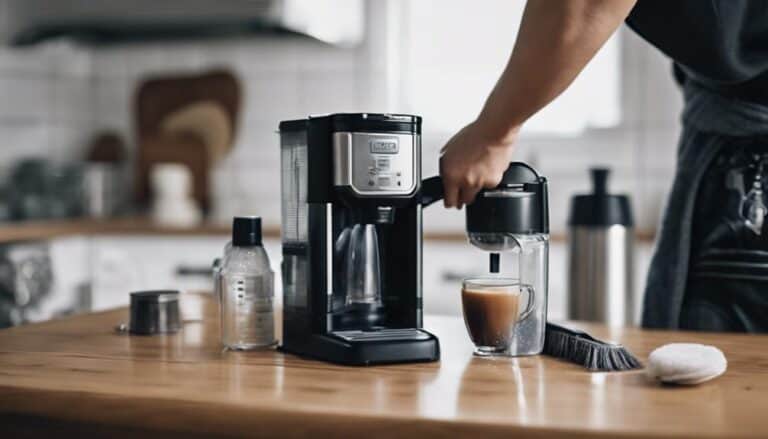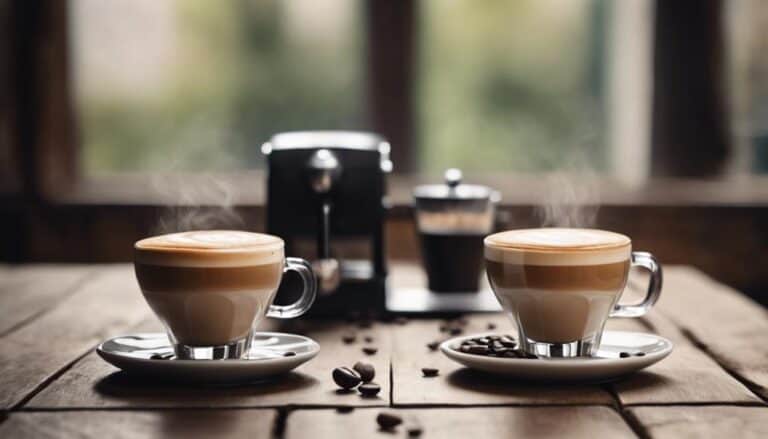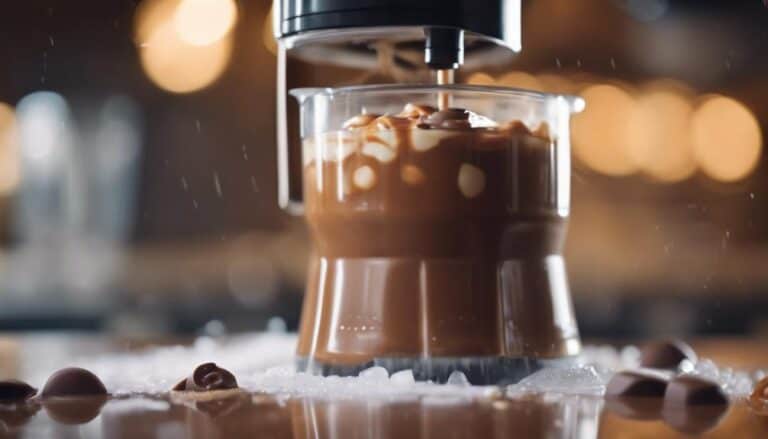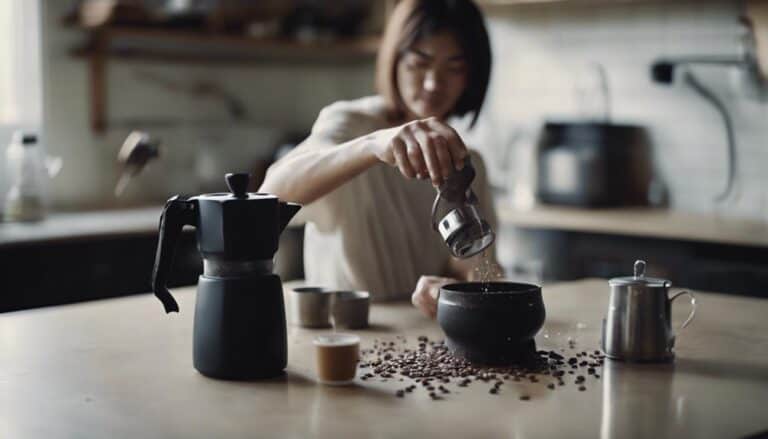Longshot Vs Ristretto Comparison
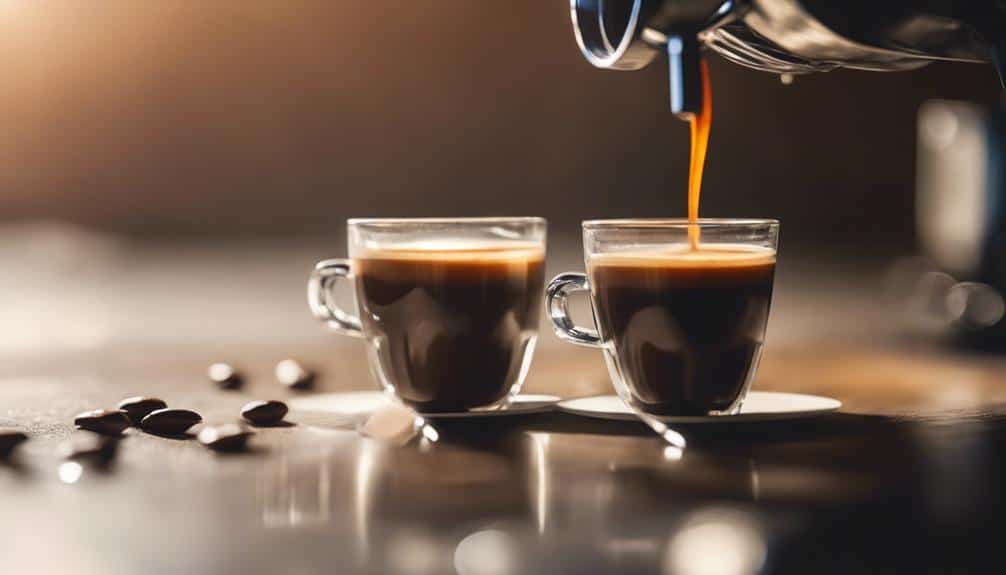
When comparing Long Shot and Ristretto espresso shots, the nuances in flavor, strength, and extraction methods become apparent. Each shot offers a unique experience, catering to diverse palates and preferences. The debate between the bold intensity of Ristretto and the smoother taste of Long Shot sparks curiosity about which factors truly define a perfect espresso. As we explore the differences in volume, grind size, and coffee beans, a deeper understanding of these two beloved espresso varieties emerges, inviting us to unravel the complexities behind our daily caffeine fix.
Flavor Profiles Compared
When comparing the flavor profiles of Longshot and Ristretto, it becomes evident that each offers a distinct sensory experience due to differences in extraction time and intensity.
Ristretto, known for its bold and intense flavors with rich coffee notes, is achieved through a shorter extraction time during the brewing process. This intensity creates a robust taste that lingers on the palate, appealing to those who prefer a bolder coffee experience.
In contrast, Longshot presents a smoother flavor profile, with a milder taste compared to Ristretto. This milder taste is a result of a longer extraction time, allowing for a more subtle extraction of flavors.
The bolder and richer notes in Ristretto stand out against the smoother and less intense backdrop of Longshot. Understanding how extraction time influences these distinct flavor profiles is key to appreciating the nuances between the two coffee options.
Strength Variation Between the Two
Comparing the strength variation between Ristretto and Long Shot reveals distinct differences in their intensity levels, reflecting the concentrated boldness of Ristretto against the milder approach of Longshot. Ristretto, known for its concentrated flavor and higher caffeine content per ounce, is brewed with a shorter extraction time and a higher coffee-to-water ratio compared to Long Shot. The brewing process plays an essential role in determining the strength difference between the two, along with factors like grind size and extraction time.
Ristretto's intense profile appeals to coffee enthusiasts seeking a robust and bold coffee experience, while Long Shot caters to those favoring a smoother, milder taste. Preferences for strength vary among individuals, with some gravitating towards the rich and powerful notes of Ristretto, while others prefer the subtler flavors of Long Shot. Understanding these distinctions allows coffee lovers to choose the espresso shot that aligns with their desired taste intensity.
Volume Differences in Espresso Shots
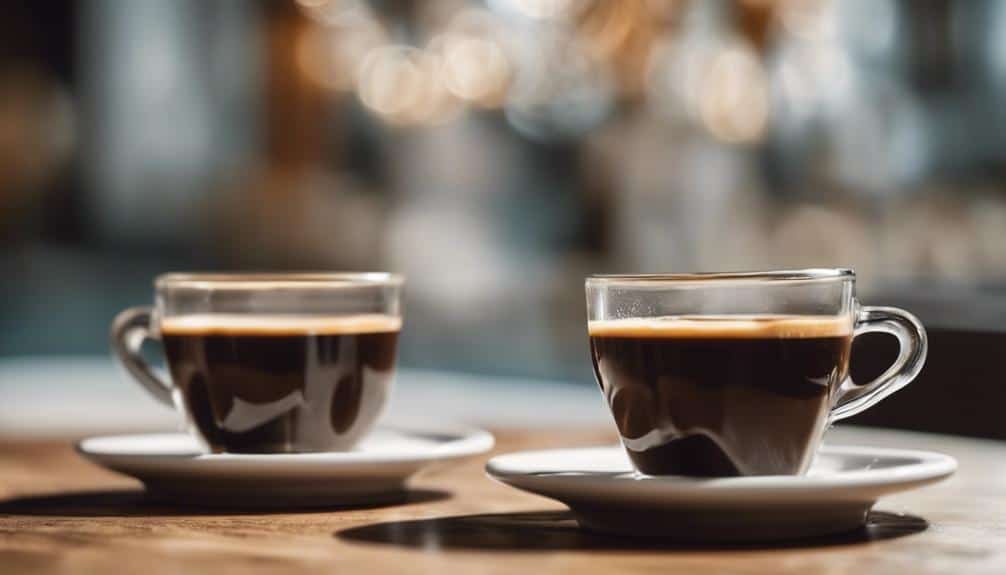
The volume disparities between Ristretto and Long Shot espresso shots greatly impact the overall tasting experience and intensity levels. When comparing the two, the main difference lies in the amount of water used during brewing.
A Long Shot espresso, as the name suggests, uses a longer extraction process and a larger amount of water, resulting in a final volume of 2–3 ounces. This increased volume dilutes the intensity of the espresso, making it a preferred choice for those seeking a milder taste profile.
On the other hand, Ristretto, with its shorter extraction time and smaller amount of water, typically yields 0.5–0.75 ounces of coffee. This condensed brewing method produces a more concentrated flavor, appealing to individuals who enjoy a stronger and bolder espresso experience.
Ultimately, the volume difference between Long Shots and Ristretto plays a vital role in shaping the flavor profile and overall enjoyment of the espresso shot.
Grind Size Impact on Taste
When considering the impact of grind size on taste in espresso, it becomes evident that the fineness or coarseness directly influences the flavor extraction process.
The nuanced variations in grind size can lead to a spectrum of taste perceptions, ranging from intense and concentrated to milder and smoother profiles.
Understanding the relationship between grind size and taste perception is essential in achieving the desired balance and richness in espresso shots.
Grind Size Influence
Using a finer grind size enhances the intensity and concentration of ristretto's flavor profile compared to long shots. The grind size directly affects the extraction process and the resulting taste experience.
Here are some key points to keep in mind:
- Precision in grind size is important for achieving the desired taste and characteristics.
- A finer grind for ristretto intensifies flavors due to increased surface area.
- Long shots with a coarser grind offer a smoother, milder taste.
- Grind size influences the rate of extraction, impacting the balance of flavors.
- Adjusting the grind size allows for tailoring the taste and characteristics of both ristretto and long shots to your preference.
Taste Perception Variation
Enhancing the grind size of espresso beans significantly impacts the perceived taste profiles of both ristretto and long shots, influencing the flavor intensity and overall experience.
A finer grind, characteristic of ristretto, results in a bolder, sweeter profile due to the concentrated flavors extracted in a shorter time. Conversely, the coarser grind of long shots leads to a smoother, less bitter taste as the extraction process is prolonged, allowing for a milder flavor.
The extraction time for ristretto is shorter, creating a more intense flavor experience, while long shots offer a gentler taste profile with a longer extraction time.
Understanding the relationship between grind size and taste perception is important in crafting the perfect espresso shot tailored to individual preferences.
Extraction Efficiency Connection
Grind size selection directly influences the extraction efficiency and subsequent taste disparities between ristretto and long shots.
- The grind size for ristretto is finer than for long shots, impacting the extraction efficiency and flavor intensity.
- Finer grind for ristretto allows for a quicker extraction process, resulting in a more concentrated and bold taste.
- Coarser grind for long shots leads to a longer extraction time, producing a milder and smoother flavor profile.
Grind size plays an essential role in connecting extraction efficiency to the taste differences between ristretto and long shots.
Understanding the impact of grind size on extraction efficiency enhances the appreciation of the distinct flavors of ristretto and long shots.
Caffeine Content Examination
When comparing the caffeine content between ristretto and long shots, it becomes apparent that ristretto generally boasts a higher concentration of caffeine per ounce due to its concentrated extraction method. A ristretto shot is made using a smaller amount of water, resulting in a more intense and concentrated flavor profile, which also translates to a higher caffeine content. On the other hand, long shot coffee, despite using more water, contains less caffeine overall, making it a milder option for those looking to reduce their caffeine intake. The differences between a ristretto and a long-shot coffee can be essential for individuals managing their caffeine consumption based on their tolerance levels and preference for flavor intensity.
| Caffeine Content Per Ounce | Intensity of Flavor |
|---|---|
| Ristretto has higher caffeine concentration | Ristretto offers a more intense and concentrated flavor |
| Long shots contain less caffeine | Long shots provide a milder flavor profile |
Brewing Techniques Contrasted
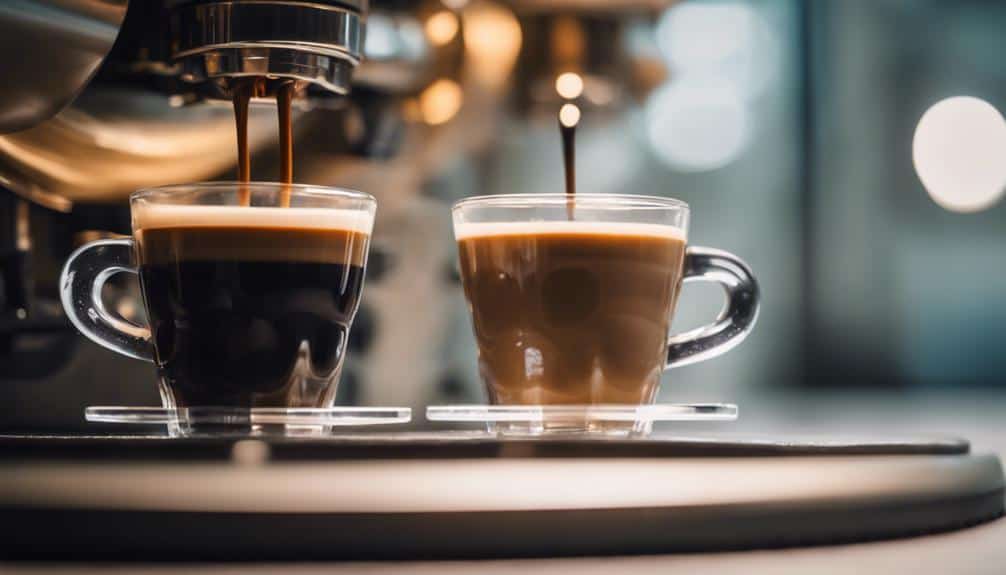
When comparing brewing techniques between a long shot and a ristretto, two key points emerge: the impact of grind size and the differences in extraction time.
The finer grind required for ristretto results in a shorter extraction time, while long shots demand a coarser grind and a longer brew time for best flavor.
Understanding these nuances is key to mastering the distinct characteristics of each espresso style.
Grind Size Impact
In my exploration of contrasting brewing techniques, the impact of grind size on flavor extraction emerges as an essential factor for examination. When comparing Ristretto and long shots, the grind size plays a vital role in determining the final flavor profile. Here are some key points to keep in mind:
- Ristretto demands a finer grind size for a concentrated flavor extraction.
- Long shots utilize a coarser grind size, resulting in a milder taste profile.
- The grind size directly influences the extraction process by affecting surface area.
- Finer grinds in Ristretto enhance extraction of coffee solubles, contributing to a richer taste.
- Coarser grinds in long shots allow for a longer extraction time, leading to a smoother and less intense flavor profile.
Extraction Time Differences
Comparing the extraction times between Ristretto and long shots reveals distinct nuances in flavor intensity and balance, showcasing the intricate interplay between time and taste in espresso brewing techniques.
Ristretto, with its shorter extraction time of around 20-25 seconds, focuses on intensified flavor and aroma extraction, resulting in a bold and robust espresso.
On the other hand, long shot, requiring 30-35 seconds for peak extraction, delivers a more balanced taste profile with milder undertones.
The precision in extraction time is paramount in capturing the distinct characteristics of each brew.
Whether opting for the quick jolt of flavor from ristretto or the smoother, more extended extraction of a long shot, understanding the impact of time on flavor extraction is key to mastering the art of espresso brewing.
Ideal Coffee Beans for Each
To achieve the best flavor profiles for Longshot and Ristretto espresso shots, selecting the right coffee beans is essential. When it comes to choosing the ideal coffee beans for each type of shot, there are specific considerations to keep in mind:
- Ristretto: Opt for high-quality Arabica beans to achieve a rich and intense flavor profile that characterizes this short and robust shot.
- Longshot: A blend of Arabica and Robusta beans works best for a balanced and milder taste that complements the longer extraction process.
- Specialty Single-Origin: Enhance the complexity of your Ristretto shots by using specialty single-origin coffee beans, which bring unique and nuanced flavors to the forefront.
- Medium Roast: For Long Shots, select medium roast coffee beans to maintain a smooth and approachable flavor profile that appeals to a wider audience.
- Coffee Bean Origins: Experimenting with different coffee bean origins can elevate the taste experience of both Ristretto and Longshot espresso shots, allowing you to discover new and exciting flavor combinations.
Health Benefits and Considerations

Exploring the health implications of consuming espresso, particularly ristretto and long shots, reveals valuable insights into the impact of these coffee variants on our well-being. Espresso, rich in antioxidants, can aid in reducing inflammation within the body. The caffeine present in espresso acts as a mood enhancer and energy booster; however, it's important to consume it in moderation to prevent potential side effects.
Ristretto, despite containing more caffeine per ounce than long shots, has a lower overall caffeine content due to its smaller serving size. Both ristretto and long shots are low in calories, but the addition of milk or sugar can increase the calorie count.
Understanding the health benefits and considerations of espresso variants like ristretto and long shots empowers individuals to make informed choices about their coffee consumption, ensuring they derive maximum enjoyment and wellness from their daily brew. Making mindful decisions regarding caffeine intake and calorie consumption can contribute to a balanced lifestyle.
Conclusion
To sum up, the comparison between Long Shot and Ristretto highlights the diverse range of flavors, strengths, and brewing techniques available in the world of espresso. Each option caters to different preferences, whether you enjoy a bold and intense experience or a smoother, milder taste.
Understanding the nuances of volume, grind size, extraction time, and coffee beans is essential in appreciating the unique characteristics of these espresso shots. Ultimately, the choice between Long Shot and Ristretto comes down to personal taste and preference.
